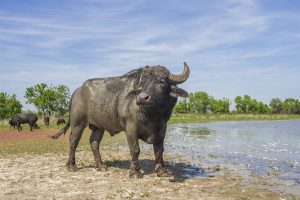
24 interesting facts about saolas
- 👁️ 972
The saola, often referred to as the Asian unicorn, is one of the world’s most elusive and rare mammals, discovered only in 1992 in the Annamite Range of Vietnam and Laos. This discovery astonished the scientific community, as it was the first large mammal new to science in more than 50 years, highlighting the biodiversity of the region and the mysteries the natural world still holds. Saolas are a symbol of the rich, yet threatened, ecosystems they inhabit, and their existence emphasizes the importance of conservation efforts in Southeast Asia. With their distinctive long horns and secretive nature, saolas remain a profound reminder of the wild’s untouched beauty and the urgent need to protect such irreplaceable treasures. Here are 24 interesting and informative facts about the saola.
- The saola (Pseudoryx nghetinhensis) was discovered in May 1992 by a joint Vietnamese-Russian survey in the Vu Quang Nature Reserve.
- Saolas are recognized by their strikingly long, straight horns, which can grow up to 20 inches in length.
- They belong to the family Bovidae, which includes antelopes, bison, and cattle.
- Saolas are known to inhabit only the Annamite Range’s dense forests along the Vietnam-Laos border.
- With no confirmed population estimates available, saolas are considered one of the rarest large mammals on Earth.
- They have been categorized as Critically Endangered by the IUCN Red List of Threatened Species.
- Saolas are often called the “Asian unicorn,” not because they have a single horn, but due to their rarity and elusiveness.
- The species is so elusive that it has been primarily documented through camera traps and indirect signs, like footprints or locally reported sightings.
- Saolas have a unique gland between their hooves that is thought to be used for marking territory.
- They are known to eat a variety of forest vegetation, including leaves and fruits from small trees and bushes.
- No saola has ever survived in captivity; the few attempts made have all resulted in the animals’ deaths within days or months.
- Genetic studies suggest that saolas diverged from other members of the Bovidae family about 14 to 15 million years ago.
- Their distinct facial markings include striking white markings on the face, which contrast with their otherwise dark brown body.
- Saolas are solitary animals, and little is known about their social structure.
- The Vietnamese government has established the Saola Nature Reserves in areas where saolas have been found, to protect their habitat.
- Hunting and habitat loss are the major threats to their survival, with snares intended for other animals inadvertently capturing saolas.
- There have been only a handful of saola sightings since their discovery, making them one of the least observed large animals in the wild.
- The discovery of the saola was based on a skull with peculiar long horns found in a hunter’s home, sparking scientific interest.
- Conservation efforts for saolas include anti-poaching patrols and community engagement to reduce hunting pressure.
- Saolas play a mysterious role in their ecosystem, with their exact ecological niche and impact on their habitat remaining largely unknown.
- They are believed to be seasonal breeders, but details on their reproduction and life cycle are scarce.
- The name “saola” has been translated to mean “spindle horns” in Vietnamese.
- International conservation organizations, including the World Wildlife Fund and the International Union for Conservation of Nature, are involved in efforts to save the saola.
- The saola’s existence is a reminder of the undiscovered species that may be lost before being identified due to human impacts on natural habitats.
The saola’s discovery and ongoing mystery underscore the vast unknowns still present in the natural world and the importance of preserving biodiversity. Their critical status highlights the urgency of conservation efforts needed to ensure their survival. Through continued research and protective measures, there is hope that the saola will not become a ghostly legend but remain a thriving member of our planet’s biodiversity, inspiring future generations with its enigmatic presence and the story of its late discovery.











